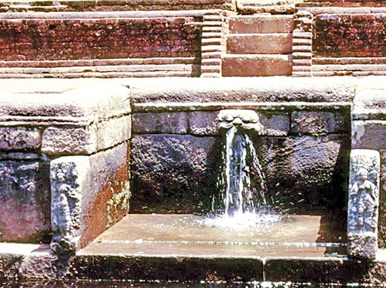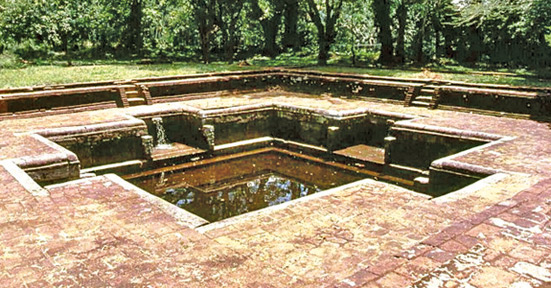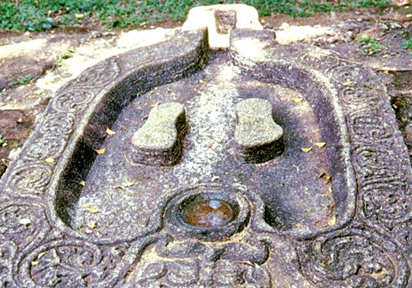Verdant beauty of royal bathing pond at Galebedde
By Mahil Wijesinghe
Monaragala, one of the major cities in the Uva Province is steeped in
history. It was an ancient city of the Ruhunu Kingdom and is full of
legend, romance and history. Studding the entire province is a vast
complex of ancient temples, devales, rock cave shelters, hermitages and
dagabas which date back to the medieval kingdom of Anuradhapura.
|

Water flowing through the lionís mouth into the pond |
During my recent visit to Monaragala's interior, we took photographs
of some of the historical places that were venerated by kings and queens
centuries ago. Today, they lie covered by dense foliage sans any human
presence. We saw the pristine glory as well as the ruins of invaluable
historical sites made of brick and stone now vandalised beyond
recognition by unscrupulous individuals.
The Galebedde royal bathing pond was my first destination. It was an
ancient pleasure garden of queens set in a beautiful, serene
environment.
The verdant mountain range of Maragala, rich in cool water springs,
rising to the sky through the plain landscape of drought-ridden
Monaragala is like a dressed up glamorous maiden silently awaiting
admiration from everyone.
One sunny morning Jagath Sirisena, Range Forest Officer (RFO) of
Monaragala and I were in Galebedde just 20 kilometres from Monaragala
town lying between Monaragala and Siyabalanduwa on the A4 highway under
the shadow of the Maragala mountain range.
Although the cloudless blue sky provides no protection to the plain
landscape of Monaragala from the scorching sun, the village of Galebedde
is abundant with greenery and water resources.
This unique historical village of Galebedde proudly hides a
magnificent creation called Galebedde Royal Bathing Pond which was used
by queens and princesses of a bygone era.
A marvel of ancient bricks and stone and a work of massive
magnificence, the bathing pond in Galebedde has evoked awe and
admiration especially because of its ancient hydraulic water engineering
management system.
 |
|
The Galebedde pond |
It has inspired research by historians, scholars and archaeologists
in Sri Lanka. If you travel to the Eastern part of the country via the
A4 highway just passing Moneragala town within half and hour you can
reach Galebedde village and on the right side of the road one will
notice the usual Archaeological Department notice board which leads to
the royal bathing pond of Galebedde.
History has it that this royal bathing pond was once a part of a
pleasure garden of the nearby royal palace constructed in the 12th
century AC by one of the kings of Ruhuna and it was the home of Queen
Sugala, a mother of one of the late rulers of Ruhuna. It is believed
that the pond was used by Queen Sugala. Mostly the queen used it to
bathe and play water sports.
The name of queen Sugala is widely used in ancient chronicles
relating to the work done in ancient times in the Pahala-Uva and Ruhuna
province.
The Galebedde royal bathing pond is unique because it has a specific
design unlike the ponds in Anuradhapura and Polonnaruwa. This bathing
pond contains five platforms. To build the entire structure, ancient
engineers have used square granite and bricks.
Four beautiful stone- sculptured lion heads have been built equally
on the four sides of the pond and engineers have created underground
tunnels to direct water through the mouths of the four lions to the
pond. It is an awe-inspiring mechanism and is a unique feature in the
pond.
Besides each lion's face are two beautiful nude female figures
sculptured in stone. Each platform, up to the fourth from bottom of the
pond is filled with water.
|

Toilet stone at the site |
All these four platforms were built with square granite and the fifth
platform, which is above water level, was entirely built with brick.
The water flow up to the fourth platform where the lion figures
stand, and the excess water is directed beneath the pond. No one can see
where the excess water flows. On the surface of the pond, the fifth
platform, there lies a huge toilet slab in the corner made of stone and
carved out of beautiful floral designs and also two foot prints and a
place to keep a water pot in front.
Although the ancient water flowing system is not exactly functional
today, the Department of Archaeology has renovated the pond recently and
it works fairly well now. During our visit to the pond, I was able to
photograph the water flowing through the lion's mouth to the pond as
done in the bygone era.
This royal bathing pond is one of the finest examples of our ancient
art of stone sculpturing and hydraulic water engineering of our ancient
sculptors and engineers of the past.
We left the pond with thoughts that these priceless monuments must be
preserved for posterity. It is our responsibility to protect the ancient
glory from any type of destruction. |

